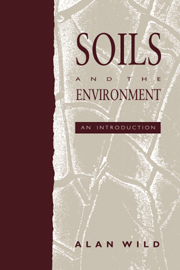Book contents
- Frontmatter
- Contents
- Preface
- Acknowledgements
- Units, symbols and general information
- 1 Introduction: soil in a natural and man-made environment
- A Soil properties and processes
- 2 The soil components
- 3 Development of soils
- 4 Sorptive properties of soils
- 5 Organisms and soil processes
- 6 Movement of water, air, solutes and heat in soil
- B Soils in relation to the environment
- Suggestions for further reading
- Index
3 - Development of soils
Published online by Cambridge University Press: 06 January 2010
- Frontmatter
- Contents
- Preface
- Acknowledgements
- Units, symbols and general information
- 1 Introduction: soil in a natural and man-made environment
- A Soil properties and processes
- 2 The soil components
- 3 Development of soils
- 4 Sorptive properties of soils
- 5 Organisms and soil processes
- 6 Movement of water, air, solutes and heat in soil
- B Soils in relation to the environment
- Suggestions for further reading
- Index
Summary
Introduction
Most of the soils at temperate latitudes in the northern hemisphere have been formed during the past 10000 years. Pre-existing soils were stripped away by glaciers or eroded by rain, melting snow and fast-flowing rivers during the Ice Ages when the land supported no more than sparse vegetation. Only a few remnants of the soils from the earlier warm interglacial periods can be found.
At southern latitudes where there was no extensive glaciation, as in Australia, soils bear clear evidence of changes of climate. Below the present soil profile can sometimes be seen an earlier profile from which the top soil was lost by erosion and on which wind-borne material was deposited.
New soils are being formed and others are being eroded at the present day; for example, eroded soil from the Himalayas is carried down rivers to form alluvial soils in Bangladesh. Fine sand from the Sahara Desert is blown into Europe, and soil is formed from recently deposited volcanic ash and recent flows of lava. Some of the most fertile soils are formed on recently deposited alluvium, as in the Nile Valley, which is derived from soil and rocks in the Ethiopian highlands. These examples, and others could be given, show that soils have a transient existence on a geological time scale.
This chapter deals with the formation of soils; erosion of soil is dealt with in Chapter 12. The processes of soil formation are usually separated into (i) rock weathering, and (ii) the addition of organic matter and the formation of structures that characterize soils, as will be done here.
- Type
- Chapter
- Information
- Soils and the Environment , pp. 37 - 53Publisher: Cambridge University PressPrint publication year: 1993



